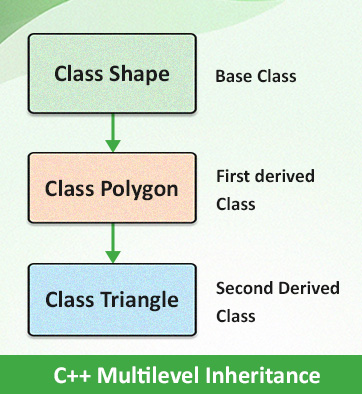
- C++ Home
- C++ Overview
- C++ Environment Setup
- C++ Basic Syntax
- C++ Comments
- C++ Hello World
- C++ Omitting Namespace
- C++ Tokens
- C++ Constants/Literals
- C++ Keywords
- C++ Identifiers
- C++ Data Types
- C++ Numeric Data Types
- C++ Character Data Type
- C++ Boolean Data Type
- C++ Variable Types
- C++ Variable Scope
- C++ Multiple Variables
- C++ Basic Input/Output
- C++ Modifier Types
- C++ Storage Classes
- C++ Numbers
- C++ Enumeration
- C++ Enum Class
- C++ References
- C++ Date & Time
- C++ Operators
- C++ Arithmetic Operators
- C++ Relational Operators
- C++ Logical Operators
- C++ Bitwise Operators
- C++ Assignment Operators
- C++ sizeof Operator
- C++ Conditional Operator
- C++ Comma Operator
- C++ Member Operators
- C++ Casting Operators
- C++ Pointer Operators
- C++ Operators Precedence
- C++ Unary Operators
- C++ Control Statements
- C++ Decision Making
- C++ if Statement
- C++ if else Statement
- C++ Nested if Statements
- C++ switch Statement
- C++ Nested switch Statements
- C++ Loop Types
- C++ while Loop
- C++ for Loop
- C++ do while Loop
- C++ Foreach Loop
- C++ Nested Loops
- C++ break Statement
- C++ continue Statement
- C++ goto Statement
- C++ Strings
- C++ Strings
- C++ Loop Through a String
- C++ String Length
- C++ String Concatenation
- C++ String Comparison
- C++ Functions
- C++ Functions
- C++ Multiple Function Parameters
- C++ Recursive Function
- C++ Return Values
- C++ Function Overloading
- C++ Function Overriding
- C++ Default Arguments
- C++ Arrays
- C++ Arrays
- C++ Multidimensional Arrays
- C++ Pointer to an Array
- C++ Passing Arrays to Functions
- C++ Return Array from Functions
- C++ Structure & Union
- C++ Structures
- C++ Unions
- C++ Pointers
- C++ Pointers
- C++ Dereferencing
- C++ Modify Pointers
- C++ Class and Objects
- C++ Object Oriented
- C++ Classes & Objects
- C++ Class Member Functions
- C++ Class Access Modifiers
- C++ Static Class Members
- C++ Static Data Members
- C++ Static Member Function
- C++ Inline Functions
- C++ this Pointer
- C++ Friend Functions
- C++ Pointer to Classes
- C++ Constructors
- C++ Constructor & Destructor
- C++ Default Constructors
- C++ Parameterized Constructors
- C++ Copy Constructor
- C++ Constructor Overloading
- C++ Constructor with Default Arguments
- C++ Delegating Constructors
- C++ Constructor Initialization List
- C++ Dynamic Initialization Using Constructors
- C++ Object-oriented
- C++ Overloading
- C++ Polymorphism
- C++ Abstraction
- C++ Encapsulation
- C++ Interfaces
- C++ Virtual Function
- C++ Pure Virtual Functions & Abstract Classes
- C++ File Handling
- C++ Files and Streams
- C++ Reading From File
- C++ Advanced
- C++ Exception Handling
- C++ Dynamic Memory
- C++ Namespaces
- C++ Templates
- C++ Preprocessor
- C++ Signal Handling
- C++ Multithreading
- C++ Web Programming
- C++ Socket Programming
- C++ Concurrency
- C++ Advanced Concepts
- C++ Lambda Expression
- C++ unordered_multiset
Multilevel Inheritance in C++
Multilevel inheritance is a type of inheritance, where a class is derived from another derived class, creating a chain of inheritance that allows it to pass down its properties and behaviors through multiple levels of classes or inherit from its predecessor.
Implementing Multilevel Inheritance
To implement multilevel inheritance, define classes in a hierarchical manner, where one class inherits from another.
Syntax
The syntax of multilevel inheritance in C++ −
class baseClass { //Here's a base class members }; class derivedClass1 : public baseClass { // Members of derivedClass1 }; class derivedClass2 : public derivedClass1 { // Members of derivedClass2 }; Here,
- baseClass is the top-level class from where other classes derive.
- derivedClass1 is the class that inherits from baseClass.
- derivedClass2 Inherits from derivedClass1, creating a multilevel structure.
Block Diagram of Multilevel Inheritance
See the below block diagram demonstrating multilevel inheritance −

As per the above diagram, "Shape" is the base class, and it is deriving over to "Polygon" class, and "Polygon" class is further deriving over "Triangle" class in order to implement multilevel inheritance.
Example of Multilevel Inheritance
In the following example, we are implementing multilevel inheritance −
#include <iostream> using namespace std; // Base class class Shape { public: void display() { cout << "This is a shape." << endl; } }; // First derived class class Polygon : public Shape { public: void sides() { cout << "A polygon has multiple sides." << endl; } }; // Second derived class class Triangle : public Polygon { public: void type() { cout << "A triangle comes under a three-sided polygon." << endl; } }; int main() { Triangle myTriangle; myTriangle.display(); // From Shape myTriangle.sides(); // From Polygon myTriangle.type(); // From Triangle return 0; } Output
This is a shape. A polygon has multiple sides. A triangle comes under a three-sided polygon.
Explanation
- Firstly, a base class named Shape has been created with a public method display(), which prints "This is a shape."
- Next, the first derived class named Polygon inherits from the Shape (or base class), meaning it gains access to the members of the Shape class, including the display()
- The second derived class, named Triangle, inherits from the Polygon class, which allows Triangle to use both display() and sides() methods.
Main Function
- An instance of a Triangle named myTriangle is created.
- display() will first access the display() method by calling the Triangle class and then the Shape class because of inheritance.
- Similarly, sides() will inherit from sides() of the Polygon class,
- and myTriangle.type() from type() of Triangle class